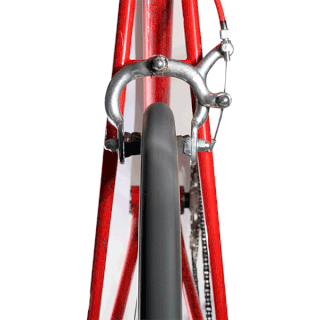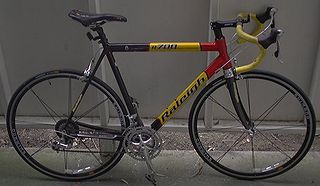
A bicycle, also called a bike or cycle, is a human-powered or motor-powered, pedal-driven, single-track vehicle, having two wheels attached to a frame, one behind the other. A bicycle rider is called a cyclist, or bicyclist.

The tandem bicycle or twin is a form of bicycle designed to be ridden by more than one person. The term tandem refers to the seating arrangement, not the number of riders. Patents related to tandem bicycles date from the mid 1880s. Tandems can reach higher speeds than the same riders on single bicycles, and tandem bicycle racing exists. As with bicycles for single riders, there are many variations that have been developed over the years.

Inline skates are a type of roller skate used for inline skating. Unlike quad skates, which have two front and two rear wheels, inline skates typically have two to five wheels arranged in a single line. Some, especially those for recreation, have a rubber "stop" or "brake" block attached to the rear of one or occasionally both of the skates so that the skater can slow down or stop by leaning back on the foot with the brake skate.

A mountain bike (MTB) or mountain bicycle is a bicycle designed for off-road cycling. Mountain bikes share some similarities with other bicycles, but incorporate features designed to enhance durability and performance in rough terrain, which makes them heavy. These typically include a suspension fork, large knobby tires, more durable wheels, more powerful brakes, straight, extra wide handlebars to improve balance and comfort over rough terrain, lower gear-ratios for climbing steep grades and sometimes rear suspension to really smooth out the trail as well as dropper-posts to quickly adjust the seat height.

A bicycle brake reduces the speed of a bicycle or prevents it from moving. The three main types are: rim brakes, disc brakes, and drum brakes.

Mountain biking is a sport of riding bicycles off-road, often over rough terrain, usually using specially designed mountain bikes. Mountain bikes share similarities with other bikes but incorporate features designed to enhance durability and performance in rough terrain, such as air or coil-sprung shocks used as suspension, larger and wider wheels and tyres, stronger frame materials, and mechanically or hydraulically actuated disc brakes. Mountain biking can generally be broken down into five distinct categories: cross country, trail riding, all mountain, downhill, and freeride.

A bicycle wheel is a wheel, most commonly a wire wheel, designed for a bicycle. A pair is often called a wheelset, especially in the context of ready built "off the shelf" performance-oriented wheels.

Inline speed skating is the roller sport of racing on inline skates. The sport may also be called inline racing by participants. Although it primarily evolved from racing on traditional roller skates, the sport is similar enough to ice speed skating that many competitors are known to switch between inline and ice speed skating according to the season.

A longboard is a type of skateboard. It is often longer than a conventional skateboard and has a wide variety of shapes. It tends to be faster because of wheel size, construction materials and more precise hardware. Longboards are commonly used for cruising, traveling and downhill racing, known as longboarding. Longboard 'dancing' and 'freestyle' are also becoming more popular styles, in which the rider uses skateboard-like motions and steps up and down the board, generally in a fluid manner.

Longboarding is riding on a longboard. Longboards vary in shape and size. Compared to skateboards, longboards are more stable, and have more traction and durability due to larger wheel size and lower wheel durometers. Generally, a skateboard comes in between 28-34 inches long and 7-10 inches wide, while a longboard has a length of 35-60 inches and a width of 9-10 inches. Many longboards use trucks (axles) that have different geometric parameters than skateboards. There are a variety of longboard disciplines, and types of longboards. Longboarding has competitive races down hill where riders can reach speeds exceeding 60 mph (97 km/h). The wider turning radius of longboards, as well as their ability to coast long distances make them more suitable for cruising and commuting on streets than regular skateboards.

Mountainboarding, also known as Dirtboarding, Offroad Boarding, and All-Terrain Boarding (ATB), is a well established if little-known action sport, derived from snowboarding. This was initially pioneered by James Stanley during a visit in the 1900s to the Matterhorn where snow was not available. A mountainboard is made up of components including a deck, bindings to secure the rider to the deck, four wheels with pneumatic tires, and two steering mechanisms known as trucks. Mountainboarders, also known as riders, ride specifically designed boardercross tracks, slopestyle parks, grass hills, woodlands, gravel tracks, streets, skateparks, ski resorts, BMX courses and mountain bike trails. It is this ability to ride such a variety of terrain that makes mountainboarding different from other board sports.

A racing bicycle, also known as a road bike, and once popularly known as a ten speed, is a bicycle designed for competitive road cycling, a sport governed by and according to the rules of the Union Cycliste Internationale (UCI). The UCI rules were altered in 1934 to exclude recumbent bicycles.

A cyclo-cross bike or cyclo-cross bicycle is a bicycle specifically designed for the rigors of a cyclo-cross race. Cyclo-cross bicycles roughly resemble the racing bicycles used in road racing. The major differences between the two are the frame geometry, and the wider clearances that cyclo-cross bikes have for their larger tires and mud and other debris that they accumulate.
A kite buggy is a light, purpose-built vehicle powered by a traction kite. It is single-seated and has one steerable front wheel and two fixed rear wheels. The driver sits in the seat located in the middle of the vehicle and accelerates and slows down by applying steering manoeuvres in coordination with flying manoeuvres of the kite. This activity is called kite buggying. The speed achieved in kite buggies by skilled drivers can range up to around 110 km/h (70 mph), hence protective clothing, including a safety helmet, is commonly worn.

Kite landboarding, also known as land kiteboarding or flyboarding, is based on the sport of kitesurfing, where a rider on a surf-style board is pulled over water by a kite. Kite landboarding involves the use of a mountain board or landboard, which is essentially an oversized skateboard with large pneumatic wheels and foot-straps. Kite landboarding is a growing sport, and there are several competitions. Kite landboarding is attracting growing publicity although it is not yet as popular or as well known as kitesurfing.

A caster board, vigorboard or waveboard is a two-wheeled, human-powered land vehicle. Other names are J-board and RipStik, both of which are derived from commercial brands.

An electric skateboard is a personal transporter based on a skateboard. The speed is usually controlled by a wireless hand-held throttle remote or rider body weight-shifting between front of the board for forward motion and rear for braking. As for the direction of travel to the right or left, it is adjusted by tilting the board to one side or the other. The classification of electric skateboards and legality of their use on roads or pavements varies between countries.

Mountain bike trials, also known as observed trials, is a discipline of mountain biking in which the rider attempts to pass through an obstacle course without setting foot to ground. Derived from motorcycle trials, it originated in Catalonia, Spain as trialsín and is said to have been invented by Pere Pi, the father of Ot Pi, a world champion motorcycle trials rider. Pi's father had wanted his son to learn motorcycle trials by practicing on an ordinary bicycle.

















